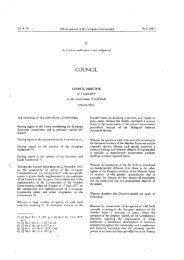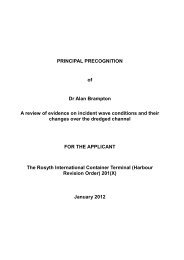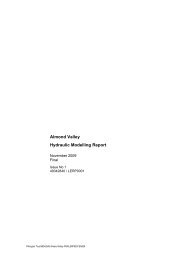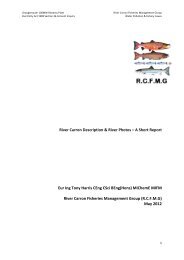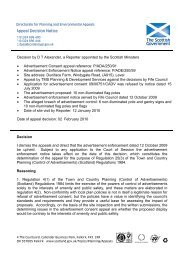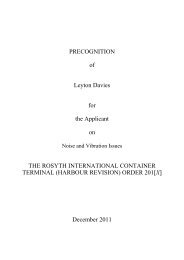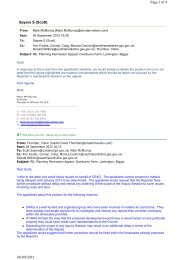Landscape architecture - Directorate for Planning and ...
Landscape architecture - Directorate for Planning and ...
Landscape architecture - Directorate for Planning and ...
Create successful ePaper yourself
Turn your PDF publications into a flip-book with our unique Google optimized e-Paper software.
1. <strong>L<strong>and</strong>scape</strong> <strong>architecture</strong> 1.1 It is widely accepted that our climate is changing <strong>and</strong> that these changes are at<br />
<strong>and</strong> climate change least in part a result of human activity. In its 2007 publication ‘Climate Change 2007:<br />
Synthesis Report – Summary <strong>for</strong> Policymakers’ the Intergovernmental Panel on<br />
Climate Change (IPCC) broadly concludes that:<br />
Position statement<br />
Page 2<br />
— CO2 levels are at their highest <strong>for</strong> 650,000 years<br />
— climate change is unequivocally happening<br />
— there is a 90% chance that this is the result of human activity<br />
— we have 10-15 years left to put in place serious measures to start reducing<br />
emissions<br />
1.2 Leading bodies researching climate change are monitoring <strong>and</strong> analysing climate<br />
patterns worldwide. The evidence that the climate is already changing is now<br />
irrefutable. These changes are set to continue, irrespective of future greenhouse gas<br />
emissions, because of the cumulative impacts of the emissions that have arisen since<br />
the onset of industrialisation. Adapting l<strong>and</strong>scapes <strong>and</strong> places to these changes is an<br />
urgent challenge <strong>for</strong> all those that have a role to play in the management of the built<br />
<strong>and</strong> natural environment.<br />
1.3 The impacts of these changes in the UK have been comprehensively researched by<br />
the UK Climate Impacts Programme (UKCIP) <strong>and</strong>, via UKCIP02, a number of <strong>for</strong>ecast<br />
scenarios have been established <strong>for</strong> the coming century based upon different future<br />
emission trends. These include:<br />
— hotter, drier summers<br />
— warmer, wetter winters<br />
— an increase in the frequency of some extreme weather events<br />
— rising sea levels<br />
1.4 These scenarios could have significant impacts upon our l<strong>and</strong>scapes, including:<br />
— Intensification of the urban heat isl<strong>and</strong> effect as a result of higher temperatures,<br />
particularly in summer, leading to risks to human health in the built environment.<br />
— Water shortages as a result of reduced rainfall <strong>and</strong> increased evapotranspiration,<br />
affecting the vitality <strong>and</strong> productivity of vegetation.<br />
— Flooding, particularly in our built environments <strong>and</strong> floodplains, as a result of<br />
increased rainfall intensity <strong>and</strong> increasingly frequent storm events.<br />
— Rising sea levels leading to significant l<strong>and</strong>scape impacts in coastal areas,<br />
including displacement of communities, social infrastructure, biodiversity <strong>and</strong><br />
alterations to l<strong>and</strong><strong>for</strong>m configurations.<br />
— Changes in biodiversity as a consequence of new climatic conditions, particularly<br />
temperature <strong>and</strong> humidity levels. As some species increase in number <strong>and</strong> range<br />
whilst others decline, food provision, the spread of diseases <strong>and</strong> our enjoyment of<br />
a healthy <strong>and</strong> aesthetically pleasing environment all st<strong>and</strong> to be affected.<br />
— Decreasing air quality as a result of higher temperatures <strong>and</strong> possible increases<br />
in ultraviolet radiation, which could have consequences <strong>for</strong> human health <strong>and</strong><br />
com<strong>for</strong>t.<br />
— The character of our l<strong>and</strong>scapes, as a changing climate impacts upon<br />
environmental, cultural, social <strong>and</strong> economic factors which shape this character.<br />
1.5 The consequences of climate change are likely to be far more severe, at least in the<br />
short term, in other parts of the world, particularly in equatorial regions where the<br />
impacts of drought <strong>and</strong> flooding are likely to have major consequences <strong>for</strong> people,<br />
wildlife <strong>and</strong> l<strong>and</strong>scapes. Climate change has the potential to render some locations<br />
uninhabitable, with conflict over access to water, energy <strong>and</strong> food already evident in<br />
some places, <strong>and</strong> this may well lead to climate-related migration to more hospitable<br />
regions such as the UK.<br />
<strong>L<strong>and</strong>scape</strong> Institute<br />
<strong>L<strong>and</strong>scape</strong> <strong>architecture</strong> <strong>and</strong> the challenge of climate change



